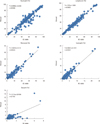Abstract
Background
The BC-6800 (Mindray, China) is a recently developed hematology analyzer that utilizes 'SF Cube Technology' to improve the reliability of complete blood counts (CBC), white blood cell (WBC) differentials, and erythroblast counts. In this study, we evaluated the performance of the BC-6800 for CBC, WBC differentials, reticulocyte counts, and erythroblast counts and analyzed the efficiency of its flag system.
Methods
Specimens from 100 healthy controls and 95 patients were used. We performed precision and correlation studies of CBC, WBC differentials, reticulocyte counts, and erythroblast counts. We also analyzed the efficiency of the flag system in detecting abnormal blood cells.
Results
The coefficients of variation (CVs) of precision were <2% for most CBC parameters and <5% for neutrophil, eosinophil, and reticulocyte counts. The results obtained using the BC-6800 were well correlated with those of the ADVIA 2120 (Siemens, USA) and LH 750 (Beckman Coulter Corporation, USA). The correlation coefficients (r) were >0.9800 for CBC except erythrocyte indices, and >0.9500 for WBC differentials except monocyte and basophil. The WBC differentials and erythroblast counts obtained using the BC-6800 were well correlated with those of manual counts. The efficiencies of the flag system were 77.9% for Blasts, 82.1% for Immature Gran, 86.3% for Atypical Lymph, and 92.6% for NRBC present.
Conclusions
The BC-6800 showed good precision and correlation with pre-existing hematology analyzers. The flag systems were quite efficient for detecting abnormal blood cells. Our study demonstrated that the BC-6800 hematology analyzer exhibits suitable performance and is helpful in routine laboratories.
Figures and Tables
 | Fig. 1'SF Cube Technology' of the BC-6800. After reaction with reagents, the blood cells undergo 3D analysis using information from laser light scatter at two angles and fluorescence signals. |
Table 1
The coefficients of variation of within run and total precisions for complete blood count parameters, white blood cell differentials, reticulocytes, and nucleated red blood cells

Abbreviations: WR, within-run; WBC, white blood cell; RBC, red blood cell; HGB, hemoglobin; HCT, hematocrit; MCV, mean corpuscular volume; MCH, mean corpuscular hemoglobin; MCHC, mean corpuscular hemoglobin concentration; RDW, red blood cell distribution width; PLT, platelet; MPV, mean platelet volume; nRBC, nucleated red blood cell.
References
2. Kang SH, Shin E, Ham CK, Kim HK, Cho HI. CELL-DYN Sapphire hematology analyzer performance evaluation on leukocyte differential counts. J Lab Med Qual Assur. 2006; 28:219–224.
3. Buttarello M, Plebani M. Automated blood cell counts: state of the art. Am J Clin Pathol. 2008; 130:104–116.
4. Johnson M, Samuels C, Jozsa N, Gorney K. Three-Way evaluation of high-throughput hematology analyzers-Beckman Coulter LH 750, Abbott Cell-Dyn 4000, and Sysmex XE-2100. Lab Hematol. 2002; 8:230–238.
5. Clinical and laboratory standards institute. EP5-A2. Evaluation of precision performance of quantitative measurement methods; approved guideline. 2nd ed. Wayne, PA: Clinical and laboratory standards institute;2004.
6. Clinical and Laboratory Standard Institute. EP9-A2. Method comparison and bias estimation using patient samples; approved guideline. 2nd ed. Wayne, PA: Clinical and Laboratory Standards Institute;2002.
7. Clinical and laboratory standards institute. H20-A2. Reference leukocyte (WBC) differential count (proportional) and evaluation of instrumental methods; approved standard. 2nd ed. Wayne, PA: Clinical and laboratory standards institute;2007.
8. Yang HY, Park SY, Suh JT, Lee HJ. Evaluation of CELL-DYN Sapphire hematology analyzer. J Lab Med Qual Assur. 2008; 30:189–194.
9. Van Hove L, Schisano T, Brace L. Anemia diagnosis, classification, and monitoring using Cell-Dyn technology reviewed for the new millenniume. Lab Hematol. 2000; 6:93–108.
10. Li J. The preliminary study of nucleated red blood cell counting by automated hematology analyzer. Sysmex J Int. 2004; 14:13–17.
11. Walters J, Garrity P. Performance evaluation of the Sysmex XE-2100 hematology analyzer. Lab Hematol. 2000; 6:83–92.
12. Lee YK, Kang HJ, Kim YM, Won CY, Cho HC. Evaluation of the ABX Pentra DX 120 for the detection of immature cells in peripheral blood. J Lab Med Qual Assur. 2008; 30:249–258.




 PDF
PDF ePub
ePub Citation
Citation Print
Print






 XML Download
XML Download